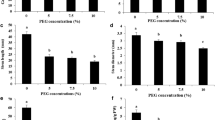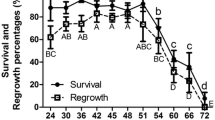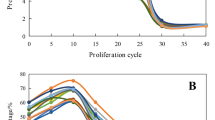Abstract
Somatic embryos of Eleutherococcus senticosus were exposed at 12, 16, 24 and 30 °C for duration of 45 days in bioreactor. The effects of such treatments on the growth, eleutheroside B, E, E1, total phenolics, flavonoids, chlorogenic acid concentrations and antioxidant enzymes activities were investigated. The results revealed that low (12 and 18 °C) and high (30 °C) temperature caused significant decrease in fresh weight (FW), dry weight (DW), total phenolics, flavonoids and total eleutheroside accumulation, while low temperature increased eleutheroside E accumulation in somatic embryos. Low temperature significantly increased superoxide dismutase (SOD), catalase (CAT), dehydroascorbate reductase (DHAR) and glutathione reductase (GR) activities whereas a strong increase in ascorbate peroxidase (APX) and monodehydroascorbate reductase (MDHAR) activity was obtained at 12 °C grown somatic embryos. In contrast, high temperature significantly decreased antioxidant enzymes activities and even guaiacol peroxidase (G-POD) activity also decreased at low temperature in comparison to 24 °C grown embryos. These data suggest that low and high temperature treatment provoked an oxidative stress in E. senticosus embryos, as shown by the increase in lipid peroxidation. The increase in lipid peroxidation was paralleled by a rise in lipoxygenase (LOX) activity and hydrogen peroxide (H2O2) content. However, this stress was more prominent at high temperature than low temperature grown embryos. This result suggests that the reduced growth of embryo at 30 °C was concomitant with reduced efficiency of these protective enzymes. On the other hand, increases in antioxidant activities at 12 and 18 °C could also be a response to the cellular damage; however, this increase could not stop the deleterious effects of low temperature, but reduced stress severity thus allowing embryo growth to occur.
Similar content being viewed by others
References
Abarca D, Roldan M, Martin M, Sabater B, (2001). Arabidopsis thaliana ecotype Cvi shows an increased tolerance to photo-oxidative stress and contains a new chloroplastic copper/zinc superoxide dismutase isoenzyme J. Exp. Bot. 52: 1417–1425
Aebi H, (1974). Catalases. In: Bergmeyer HU, (eds). Methods of Enzymatic Analysis 2 Academic Press, New York, 673–684
Alexieva V, Sergiev I, Mapelli S, Karanov E, (2001). The effect of drought and ultraviolet radiation on growth and stress markers in pea and wheat Plant Cell Environ. 24:1337–1344
Ali MB, Hahn EJ, Paek KY, (2005). Effects of temperature on oxidative stress defense systems, lipid peroxidation and lipoxygenase activity in Phalaenopsis Plant Physiol. Biochem. 43:213–223
Aroca R, Irigoyen JJ, sanchez-Diaz M, (2001) Photosynthetic characteristics and protective mechanisms against oxidative stress during chilling and subsequent recovery in two maize varieties differing in chilling sensitivity Plant Sci. 161: 719–726
Arumugam N, Bhojwani SS, (1990). Somatic embryogenesis in tissue cultures of Podophyllum hexandrum Can. J. Bot. 68:487–491
Asada K, (1999). The water–water cycle in chloroplasts: scavenging of active oxygens and dissipation of excess photons Annu. Rev. Plant Physiol. Plant Mol. Biol. 50:601–639
Axerold B, Chesbrough TM, Laakso S, (1981). Lipoxygenase from soybean. In: Lowenstein JM, (eds). Methods Enzymology Academic Press, New York, 441–451
Berry JA, Bjorkman O, (1980). Photosynthetic response and adaptation to temperature in higher plants Annu. Rev. Plant Physiol. 31:491–543
Beyer WF, Fridovich I, (1987). Assaying for superoxide dismutase activity: some large consequences of minor changes in condition Anal Biochem. 161:559–566
Bowler C, Van Montagu M, Inzé D, (1992). Superoxide dismutases and stress tolerance Annu. Rev. Plant Physiol. Plant Mol. Biol. 43:83–116
Bradford MM, (1976). A rapid and sensitive method for the quantitation of microgram quantities of protein utilizing the principle of protein-dye binding Anal. Biochem. 72:248–254
Brekhman II, Dardymov IV, (1969) Pharmacological investigation of glycosides from ginseng and Eleutherococcus Lloydia 32:46–51
Chen GX, Asada K, (1989). Ascorbate peroxidase in tea leaves: occurrence of two isozymes and the differences in their enzymatic and molecular properties Plant Cell Physiol. 30:987–998
Dat JF, López-Delgado H, Foyer C, Scott IM, (1998). Parallel changes in H2O2 and catalase during thermotolerance induced by salicylic acid or heat acclimation in mustard seedlings Plant Physiol. 116:1351–1357
Doulis AG, Debian N, Kingston-Smith AH, Foyer CH, (1997). Differential localization of antioxidants in maize Plant Physiol. 114:1031–1037
Folin O, Ciocalteu V, (1927). On trysonic and tryptophane determination in proteins J. Biol. Chem. 27:627–650
Foyer CH, Halliwell B, (1976). The presence of glutathione and glutathione reductase in chloroplasts: a proposed role in ascorbate acid metabolism Planta 133:21–25
Gaffney BT, Hugel HM, Rich PA, (2001). The effects of Eleutherococcus senticosus and Panax ginseng on steroidal hormone indices of stress and lymphocyte subset numbers in endurance athletes Life Sci. 70:431–442
Halliwell B, Gutteridge JMC, (1999). Free Radicals in Biology and Medicine, 3 Oxford University Press, Oxford, UK, 246–350
Heath RL, Packer L, (1968). Photoperoxidation in isolated chloroplasts. I. Kinetics and stoichiometry of fatty acid peroxidation Arch. Biochem. Biophys. 125: 189–198
Hossain MA, Nakano Y, Asada K, (1984) Monodehydroascorbate reductase in spinach chloroplasts and its participation in regeneration of ascorbate for scavenging hydrogen peroxide Plant Cell Physiol. 25: 385–395
Inzé D, Van Montagu M, (1995). Oxidative stress in plants Curr. Opin. Biotechnol. 6: 153–158
Levitt J, (1980). Responses of Plants to Environmental Stresses: Chilling, Freezing and High Temperatures Stresses 1. Academic Press, New York
Mittler R, (2002). Oxidative stress, antioxidants and stress tolerance Trends Plant Sci. 9:405–410
Noctor G, Foyer CH, (1998). Ascorbate and glutathione: keeping active oxygen under control Annu. Rev. Plant Physiol. Plant Mol. Biol. 49:249–279
Paek KY, Chakrabarty D, (2003). Micropropagation of woody plants using bioreactor. In: Jain SM, Ishii K, (eds). Micropropagation of Woody Trees and Fruits. Kluwer Academic Publishers, Dordrecht, 735–756
Paek KY, Chakrabarty D, Hahn EJ, (2005). Application of bioreactor system for large-scale production of horticultural and medicinal plants. In: Hvoslef-Eide AK, Preil W, (eds). Liquid Culture Systems for in vitro Plant Propagation. Springer, The Netherlands, 95–116
Pastori G, Foyer CH, Mullineaux P, (2000). Low temperature-induced changes in the distribution of H2O2 and antioxidants between the bundle sheath and mesophyll cells of maize leaves J. Exp. Bot. 51:107–113
Patrick NY, Arnason JT, Anwang DVC, (1998). An Improved extraction procedure for the rapid, quantitative high-performance liquid chromatographic estimation of the main eleutherosides (B and E) in Eleutherococcus senticosus (Eleuthero) Phyto. Anal. 9:291–295
Polle A, Morawe B, (1995). Seasonal changes of the antioxidative systems in foliar buds and leaves of field-grown beech trees (Fagus sylvatica L.) in a stressful climate Bot. Acta 108:314–320
Polle A, (1997). Defense against photo oxidative damage in plants. In: Scandalios JG (eds). Oxidative Stress and the Molecular Biology of Antioxidant Defenses, Cold Spring Harbor Laboratory Press, Cold Spring Harbor, USA, 623–666
Prasad TK, (1997). Role of catalase in inducing chilling tolerance in pre-emergent maize seedlings Plant Physiol. 114: 1369–1376
Putter J, (1974). Peroxidase In: Bergmeyer HU, (eds) Methods of Enzymatic Analysis Academic Press, New York, 685–690
Rout GR, Samantaray S, Das P, (1995). Somatic embryogenesis and plant regeneration from callus culture of Acacia catechu: a multipurpose leguminous tree Plant Cell Tiss. Org. Cult. 42:283–285
Rout GR, Samantaray S, Das P, (2000). In vitro manipulation and propagation of medicinal plants Biotechnol. Adv. 18:91–120
Sahari MA, Boostani FM, Hamidi EZ, (2004). Effect of low temperature on the ascorbic acid content and quality characteristics of frozen strawberry Food Chem. 86: 357–363
Sakanaka S, Tachibana Y, Okada Y, (2005). Preparation and antioxidant properties of extracts of Japanese persimmon leaf tea (kakinoha-cha) Food Chem. 89:569–575
Samis K, Bowley S, McKersie BD, (2002). Pyramiding Mn-superoxide dismutase transgenes to improve persistence and biomass production in alfalfa J. Exp. Bot. 53:1343–1350
Schmolz MW, Sacher F, Aicher B, (2001). The synthesis of Rantes, G-CSF, IL-4, IL-5, IL-6, IL-12 and IL-13 in human whole-blood cultures is modulated by an extract from Eleutherococcus senticosus L. roots Phytother. Res. 15:268–270
Schöner S, Krause H, (1990). Protective systems against active oxygen species in spinach: response to cold acclimation in excess light Planta 182:383–389
Shigeoka S, Ishikawa T, Tamoi M, Miyagawa Y, Takeda T, Yabuta Y, (2002). Regulation and function of ascorbate peroxidase isoenzymes J. Exp. Bot. 53:1305–1319
Shohael AM, Chakrabarty D, Yu KW, Hahn EJ, Paek KY, (2005). Application of bioreactor system for large-scale production of Eleutherococcus sessiliflorus somatic embryos in an air-lift bioreactor and production of eleutherosides J. Biotechnol. 120:228–236
Smith IK, Vierheller TL, Thorne CA, (1988). Assay of glutathione reductase in crude tissue homogenates using 5,5′-dithiobis(2-nitrobenzoic acid) Anal. Biochem. 175:408–413
Starck Z, Niemyska B, Bogdan J, Akour Tawalbeh RN, (2000). Response of tomato plants to chilling stress in association with nutrient or phosphorus starvation Plant Soil 226: 99–106
Tambussi EA, Bartoli CG, Guiamet JJ, Beltrano J, Araus JL, (2004). Oxidative stress and photo damage at low temperatures in soybean (Glycine max L. Merr.) leaves Plant Sci. 167:19–26
Ting CS, Owens TG, Wolfe DW, (1991). Seedling growth and chilling stress effects on photosynthesis in chilling-sensitive and chilling-tolerant cultivars of Zea mays J. Plant Physiol. 137:559–564
Zhong JJ, Yoshida T, (1993). Effects of temperature on cell growth and anthocyanin production by suspension cultures of Perilla frutescens cells J. Ferment. Bioeng. 76:530–531
Acknowledgements
This work was financially supported by the Ministry of Education and Human Resources Development (MOE), the Ministry of Commerce, Industry and Energy (MOCIE) and the Ministry of Labor (MOLAB) through fostering the project in the Lab of Excellency in Research Center for the Development of Advanced Horticultural Technology at Chungbuk National University, Cheong-ju 361-763, Republic of Korea. We are thankful to Professor Rafiul Islam, Department of Botany, University of Rajshahi, Bangladesh, for reviewing the manuscript.
Author information
Authors and Affiliations
Corresponding author
Rights and permissions
About this article
Cite this article
Shohael, A.M., Ali, M.B., Yu, KW. et al. Effect of temperature on secondary metabolites production and antioxidant enzyme activities in Eleutherococcus senticosus somatic embryos. Plant Cell Tiss Organ Cult 85, 219–228 (2006). https://doi.org/10.1007/s11240-005-9075-x
Received:
Accepted:
Published:
Issue Date:
DOI: https://doi.org/10.1007/s11240-005-9075-x




